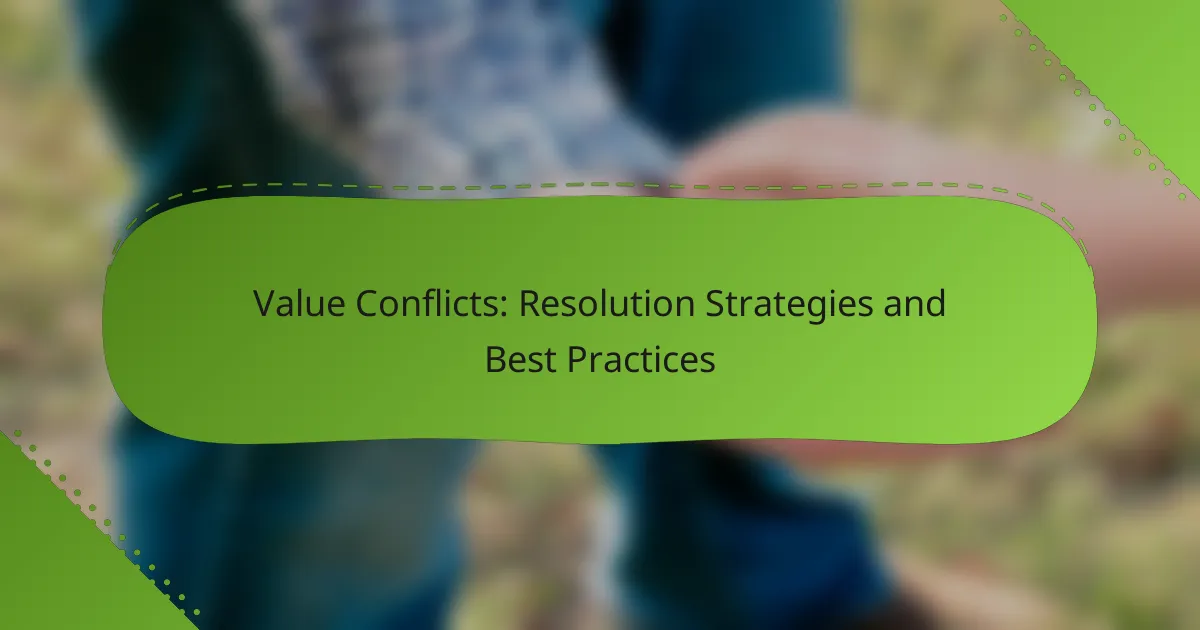Value conflicts can significantly impact workplace dynamics, stemming from differences in personal beliefs, organizational goals, and cultural backgrounds. To effectively resolve these conflicts, it is essential to prioritize understanding the underlying interests of all parties involved. By implementing structured approaches that promote collaboration and communication, organizations can foster an environment where differing values are respected and satisfactory outcomes are achieved for everyone.
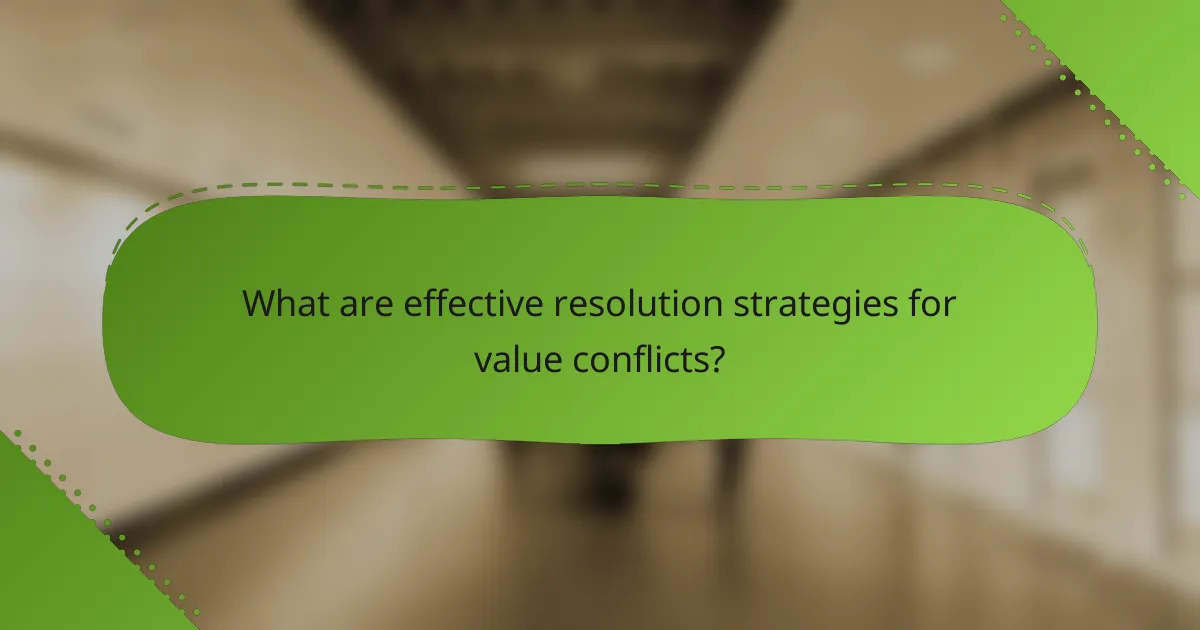
What are effective resolution strategies for value conflicts?
Effective resolution strategies for value conflicts involve approaches that prioritize understanding and addressing the underlying interests of all parties involved. These strategies aim to foster collaboration and create solutions that respect differing values while achieving a satisfactory outcome for everyone.
Collaborative negotiation
Collaborative negotiation focuses on open communication and cooperation between conflicting parties. This approach encourages participants to share their perspectives and work together to find mutually beneficial solutions. Key steps include identifying common goals, brainstorming options, and evaluating alternatives based on shared interests.
To implement collaborative negotiation, establish a safe environment for discussion and actively listen to each party’s concerns. Avoid adversarial tactics, as they can escalate tensions and hinder progress.
Interest-based mediation
Interest-based mediation involves a neutral third party facilitating discussions to help conflicting parties identify their underlying interests. This method emphasizes understanding the motivations behind each party’s position, which can lead to more creative and acceptable solutions.
During interest-based mediation, the mediator guides the conversation, ensuring that all voices are heard and that the focus remains on interests rather than positions. This approach can be particularly effective in resolving disputes where values are deeply held and entrenched.
Compromise solutions
Compromise solutions involve each party making concessions to reach an agreement that, while not perfect for anyone, is acceptable to all. This strategy can be effective when time is limited or when parties are unwilling to engage in more extensive negotiations.
To achieve a successful compromise, clearly outline the key issues at stake and encourage parties to prioritize their most important values. Be prepared for some give-and-take, and ensure that the final agreement reflects a balance of interests.
Third-party arbitration
Third-party arbitration is a formal process where an impartial arbitrator makes a binding decision to resolve a value conflict. This approach is often used when parties cannot reach an agreement through negotiation or mediation and require a definitive resolution.
In arbitration, both parties present their cases, and the arbitrator evaluates the evidence before rendering a decision. While this method can provide a quick resolution, it may not fully address the underlying values and interests of the parties involved.
Consensus-building techniques
Consensus-building techniques aim to create agreements that all parties can support, fostering a sense of ownership and commitment to the outcome. This approach often involves collaborative discussions, brainstorming sessions, and iterative feedback loops to refine proposals.
To effectively build consensus, encourage participation from all stakeholders and ensure that everyone has a chance to contribute. Use techniques such as facilitated workshops or focus groups to gather diverse perspectives and enhance the likelihood of achieving a widely accepted solution.
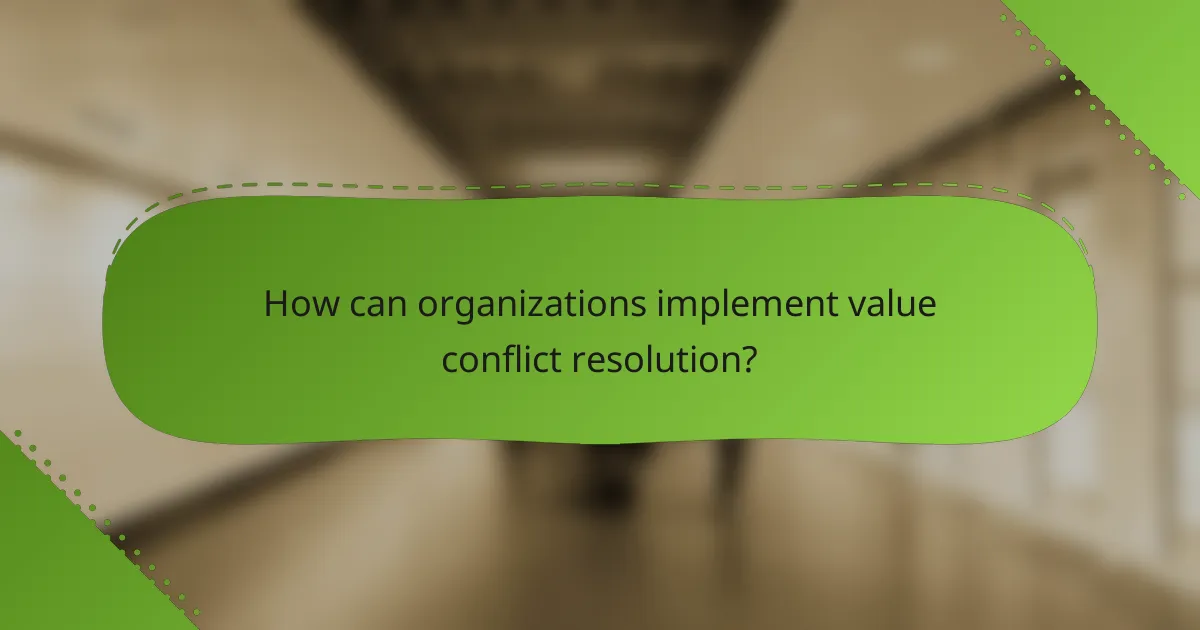
How can organizations implement value conflict resolution?
Organizations can implement value conflict resolution by adopting structured approaches that promote understanding and collaboration among stakeholders. Key strategies include training programs, establishing communication channels, and creating formal conflict resolution policies.
Training programs for conflict resolution
Training programs are essential for equipping employees with the skills needed to navigate value conflicts effectively. These programs should focus on active listening, empathy, and negotiation techniques, allowing participants to practice real-life scenarios.
Consider offering workshops that range from a few hours to several days, depending on the complexity of the topics covered. Regularly scheduled training sessions can reinforce these skills and keep conflict resolution top of mind.
Establishing clear communication channels
Clear communication channels are vital for addressing value conflicts promptly and effectively. Organizations should encourage open dialogue through regular meetings, feedback sessions, and anonymous reporting systems, ensuring that all voices are heard.
Utilizing digital tools, such as collaboration platforms or internal messaging systems, can facilitate ongoing communication. Establishing guidelines for respectful discourse can help maintain a constructive environment during discussions.
Creating a conflict resolution policy
A well-defined conflict resolution policy provides a framework for addressing disputes consistently and fairly. This policy should outline the steps employees should take when conflicts arise, including who to approach and the timeline for resolution.
Involving employees in the development of this policy can enhance buy-in and adherence. Regular reviews and updates to the policy ensure that it remains relevant and effective in addressing the evolving needs of the organization.

What are the common causes of value conflicts in the workplace?
Value conflicts in the workplace often arise from differences in personal beliefs, organizational objectives, and cultural backgrounds. Understanding these causes is crucial for effective conflict resolution and maintaining a harmonious work environment.
Differing personal values
Differing personal values can lead to misunderstandings and friction among team members. For instance, an employee who prioritizes work-life balance may clash with a colleague who values dedication and long hours. Recognizing these differences is essential for fostering a respectful workplace.
To navigate these conflicts, encourage open dialogue where employees can express their values and perspectives. This can help in finding common ground and establishing shared goals that respect individual beliefs.
Competing organizational goals
Competing organizational goals can create value conflicts when departments prioritize different outcomes. For example, a sales team focused on revenue growth may conflict with a customer service team aiming for high satisfaction ratings. These competing objectives can lead to tension and misalignment within the organization.
To address this, organizations should clearly communicate overarching goals and encourage collaboration between teams. Regular meetings can help align efforts and ensure that all departments understand how their objectives contribute to the company’s success.
Cultural misunderstandings
Cultural misunderstandings often stem from diverse backgrounds and can lead to significant value conflicts. Different cultures may have varying views on authority, teamwork, and communication styles, which can result in misinterpretations and frustration among employees.
To mitigate these issues, organizations should provide cultural competency training and promote an inclusive environment. Encouraging employees to share their cultural perspectives can enhance mutual understanding and reduce potential conflicts.
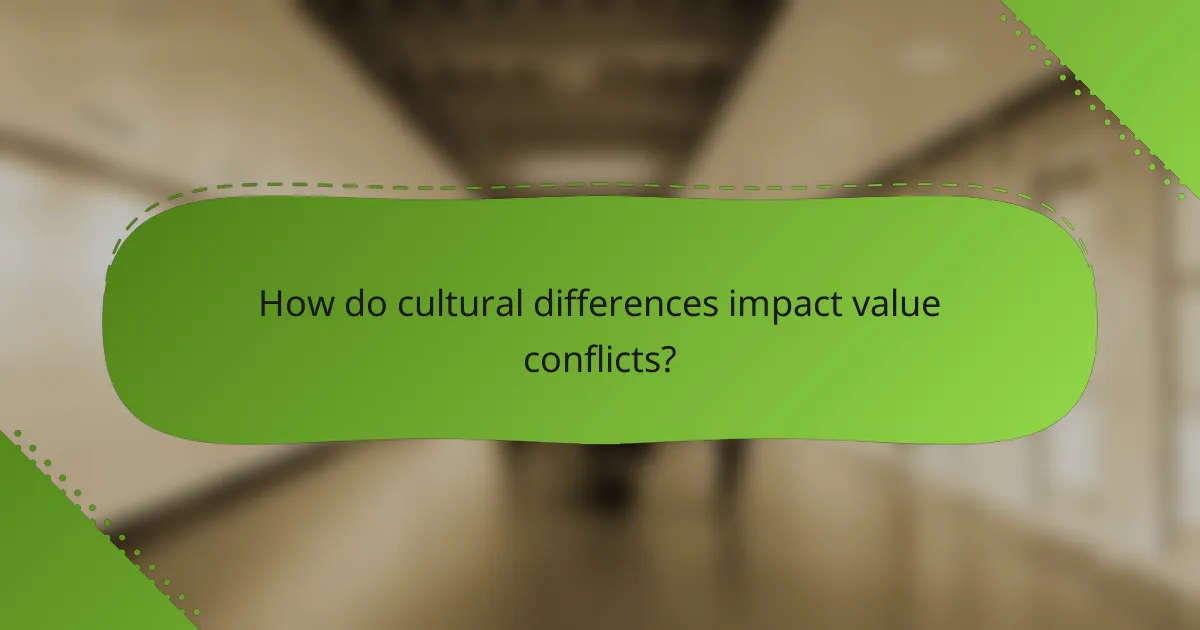
How do cultural differences impact value conflicts?
Cultural differences significantly influence value conflicts by shaping individuals’ beliefs, behaviors, and communication styles. These differences can lead to misunderstandings and disagreements, making it essential to recognize and navigate them effectively.
Variations in communication styles
Communication styles vary widely across cultures, affecting how individuals express their values and resolve conflicts. For instance, some cultures prioritize direct communication, while others may favor indirect approaches to maintain harmony. Understanding these variations can help mitigate misunderstandings and foster more productive discussions.
When addressing value conflicts, consider adapting your communication style to match that of the other party. This might involve being more explicit in some contexts or more subtle in others, depending on cultural norms.
Conflicting ethical standards
Cultural backgrounds often shape differing ethical standards, which can lead to value conflicts in decision-making. For example, what is considered acceptable in one culture may be viewed as unethical in another. Recognizing these differences is crucial for finding common ground.
To navigate conflicting ethical standards, engage in open dialogue about each party’s values and the reasoning behind them. This approach can help identify shared principles and facilitate compromise.
Influence of cultural norms
Cultural norms play a significant role in shaping individuals’ values and behaviors, impacting how conflicts arise and are resolved. Norms dictate acceptable behavior, influencing perceptions of right and wrong within a cultural context. Understanding these norms is vital for effective conflict resolution.
When addressing value conflicts, consider the cultural norms at play. This may involve researching the other party’s cultural background or seeking guidance from cultural experts to ensure respectful and informed interactions.
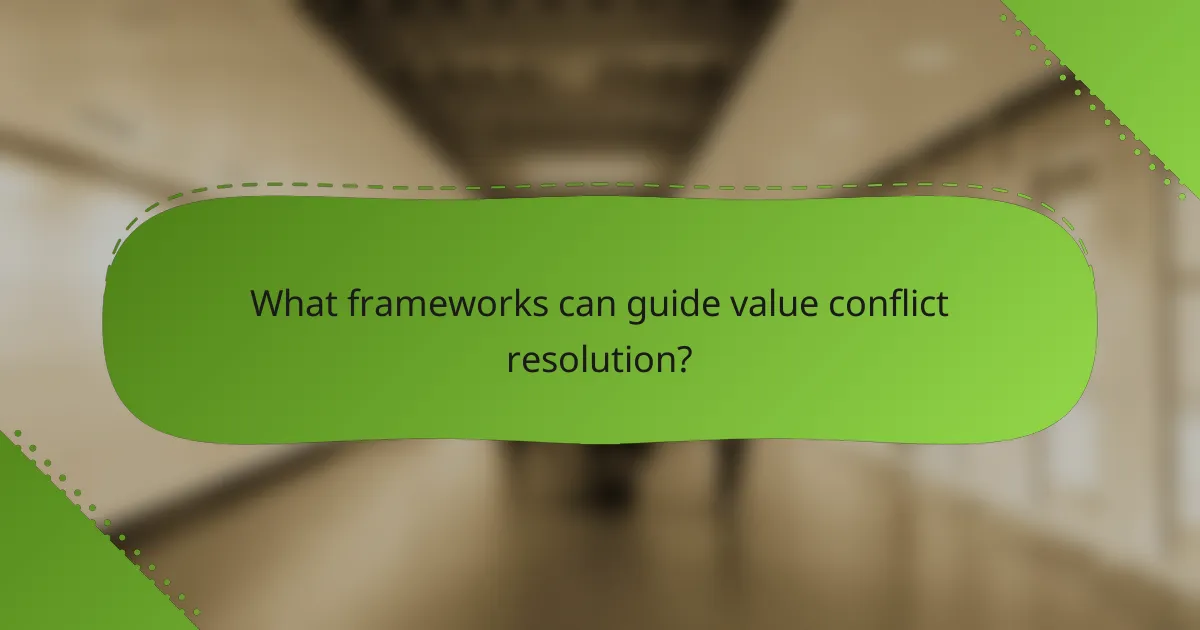
What frameworks can guide value conflict resolution?
Several frameworks can effectively guide the resolution of value conflicts, helping individuals and groups navigate disagreements rooted in differing beliefs and priorities. These frameworks provide structured approaches to understanding and addressing the underlying issues, facilitating constructive dialogue and collaboration.
Thomas-Kilmann Conflict Mode Instrument
The Thomas-Kilmann Conflict Mode Instrument (TKI) identifies five primary conflict-handling styles: competing, collaborating, compromising, avoiding, and accommodating. Each style reflects different levels of assertiveness and cooperativeness, allowing individuals to choose the most appropriate approach based on the situation at hand.
To utilize the TKI effectively, assess the context of the conflict and your relationship with the other party. For instance, if the relationship is crucial, a collaborative approach may be preferred, while a competing style might be suitable for situations requiring quick decisions. Understanding these modes can help in selecting a strategy that aligns with both personal values and desired outcomes.
Interest-Based Relational Approach
The Interest-Based Relational (IBR) approach emphasizes the importance of maintaining relationships while addressing conflicts. This framework encourages parties to focus on their interests rather than positions, fostering a collaborative environment where solutions can be developed that satisfy the needs of all involved.
Key steps in the IBR approach include identifying shared interests, actively listening to each party’s concerns, and brainstorming potential solutions together. For example, in a workplace dispute over resource allocation, discussing each department’s needs can lead to a more equitable distribution that respects everyone’s priorities. Avoiding personal attacks and focusing on the issue at hand is crucial for maintaining a constructive dialogue.

What role does emotional intelligence play in resolving value conflicts?
Emotional intelligence is crucial in resolving value conflicts as it enables individuals to recognize, understand, and manage their emotions and those of others. By fostering empathy and effective communication, emotional intelligence helps navigate disagreements and find common ground.
Understanding emotional triggers
Emotional triggers are specific stimuli that provoke strong emotional responses, often linked to personal values or past experiences. Recognizing these triggers is essential for managing reactions during value conflicts, as they can escalate tensions if not addressed.
To identify emotional triggers, reflect on situations that provoke intense feelings, such as anger or frustration. Keeping a journal of these instances can help pinpoint patterns and prepare for future conflicts.
When engaging in discussions, practice active listening to acknowledge the other person’s feelings. This approach can mitigate emotional reactions and create a more constructive dialogue.
